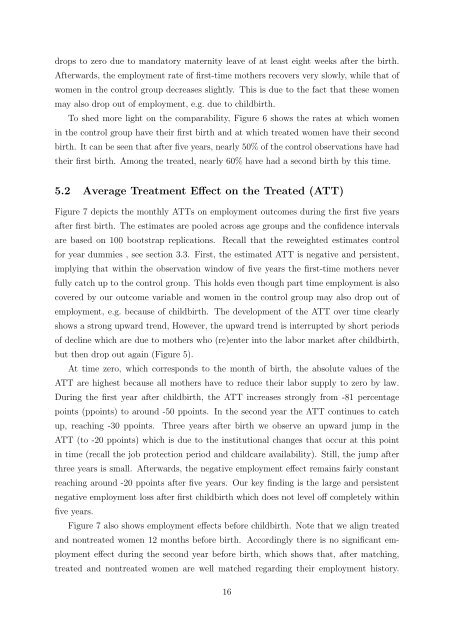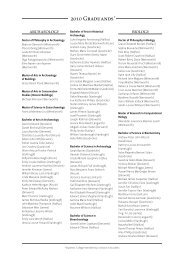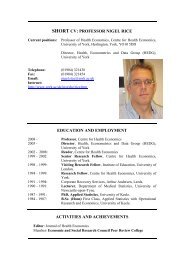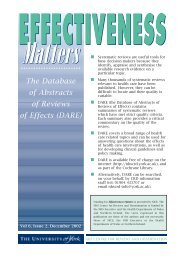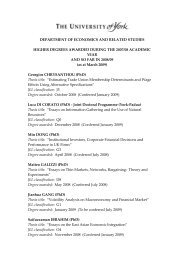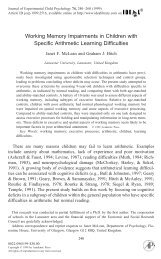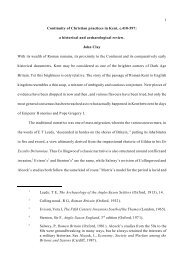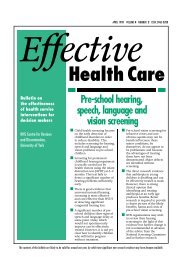Causal effects on employment after first birth - A ... - University of York
Causal effects on employment after first birth - A ... - University of York
Causal effects on employment after first birth - A ... - University of York
Create successful ePaper yourself
Turn your PDF publications into a flip-book with our unique Google optimized e-Paper software.
drops to zero due to mandatory maternity leave <strong>of</strong> at least eight weeks <strong>after</strong> the <strong>birth</strong>.Afterwards, the <strong>employment</strong> rate <strong>of</strong> <strong>first</strong>-time mothers recovers very slowly, while that <strong>of</strong>women in the c<strong>on</strong>trol group decreases slightly. This is due to the fact that these womenmay also drop out <strong>of</strong> <strong>employment</strong>, e.g. due to child<strong>birth</strong>.To shed more light <strong>on</strong> the comparability, Figure 6 shows the rates at which womenin the c<strong>on</strong>trol group have their <strong>first</strong> <strong>birth</strong> and at which treated women have their sec<strong>on</strong>d<strong>birth</strong>. It can be seen that <strong>after</strong> five years, nearly 50% <strong>of</strong> the c<strong>on</strong>trol observati<strong>on</strong>s have hadtheir <strong>first</strong> <strong>birth</strong>. Am<strong>on</strong>g the treated, nearly 60% have had a sec<strong>on</strong>d <strong>birth</strong> by this time.5.2 Average Treatment Effect <strong>on</strong> the Treated (ATT)Figure 7 depicts the m<strong>on</strong>thly ATTs <strong>on</strong> <strong>employment</strong> outcomes during the <strong>first</strong> five years<strong>after</strong> <strong>first</strong> <strong>birth</strong>. The estimates are pooled across age groups and the c<strong>on</strong>fidence intervalsare based <strong>on</strong> 100 bootstrap replicati<strong>on</strong>s. Recall that the reweighted estimates c<strong>on</strong>trolfor year dummies , see secti<strong>on</strong> 3.3. First, the estimated ATT is negative and persistent,implying that within the observati<strong>on</strong> window <strong>of</strong> five years the <strong>first</strong>-time mothers neverfully catch up to the c<strong>on</strong>trol group. This holds even though part time <strong>employment</strong> is alsocovered by our outcome variable and women in the c<strong>on</strong>trol group may also drop out <strong>of</strong><strong>employment</strong>, e.g. because <strong>of</strong> child<strong>birth</strong>. The development <strong>of</strong> the ATT over time clearlyshows a str<strong>on</strong>g upward trend, However, the upward trend is interrupted by short periods<strong>of</strong> decline which are due to mothers who (re)enter into the labor market <strong>after</strong> child<strong>birth</strong>,but then drop out again (Figure 5).At time zero, which corresp<strong>on</strong>ds to the m<strong>on</strong>th <strong>of</strong> <strong>birth</strong>, the absolute values <strong>of</strong> theATT are highest because all mothers have to reduce their labor supply to zero by law.During the <strong>first</strong> year <strong>after</strong> child<strong>birth</strong>, the ATT increases str<strong>on</strong>gly from -81 percentagepoints (ppoints) to around -50 ppoints. In the sec<strong>on</strong>d year the ATT c<strong>on</strong>tinues to catchup, reaching -30 ppoints. Three years <strong>after</strong> <strong>birth</strong> we observe an upward jump in theATT (to -20 ppoints) which is due to the instituti<strong>on</strong>al changes that occur at this pointin time (recall the job protecti<strong>on</strong> period and childcare availability). Still, the jump <strong>after</strong>three years is small. Afterwards, the negative <strong>employment</strong> effect remains fairly c<strong>on</strong>stantreaching around -20 ppoints <strong>after</strong> five years. Our key finding is the large and persistentnegative <strong>employment</strong> loss <strong>after</strong> <strong>first</strong> child<strong>birth</strong> which does not level <strong>of</strong>f completely withinfive years.Figure 7 also shows <strong>employment</strong> <str<strong>on</strong>g>effects</str<strong>on</strong>g> before child<strong>birth</strong>. Note that we align treatedand n<strong>on</strong>treated women 12 m<strong>on</strong>ths before <strong>birth</strong>. Accordingly there is no significant <strong>employment</strong>effect during the sec<strong>on</strong>d year before <strong>birth</strong>, which shows that, <strong>after</strong> matching,treated and n<strong>on</strong>treated women are well matched regarding their <strong>employment</strong> history.16


